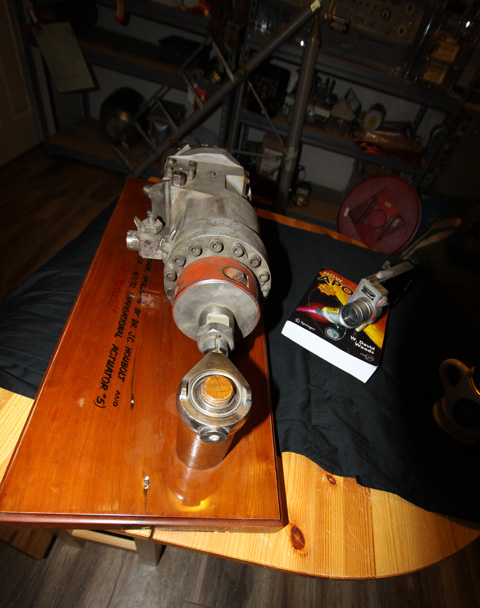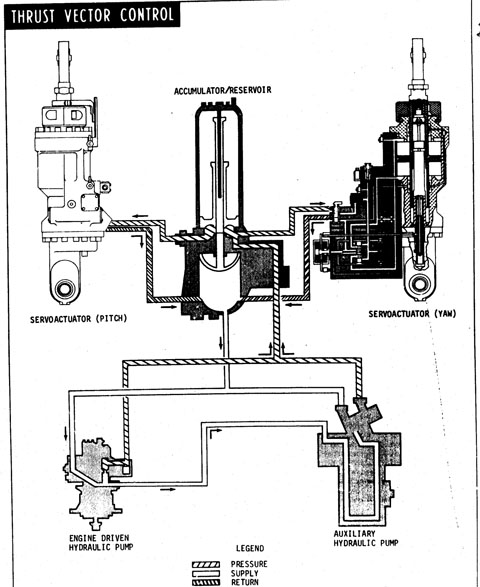|
Author
|
Topic: How do rocket engines gimbal to control flight?
|
OV3Discovery
Member Posts: 100
From:
Registered: Mar 2015
|
 posted 09-27-2015 11:43 PM
posted 09-27-2015 11:43 PM
  
How do rocket engines gimbal the thrust chamber or nozzle?I was wondering how nozzles can be vectored to control directional flight. |
SpaceAholic
Member Posts: 4437
From: Sierra Vista, Arizona
Registered: Nov 1999
|
 posted 09-28-2015 07:06 AM
posted 09-28-2015 07:06 AM
   
Most common method to achieve thrust vectoring is with actual nozzle deflection using mechanical/hydraulic actuators (usually there are two of these oriented at 90 degrees with respect to each other to allow for "X" and "Y" axis nozzle displacement). In the case of a single stage with multiple inboard/outboard engines such as the S-IC, the outboard engines are gimbaled, inboard remain fixed. Other alternatives include variable nozzle geometry/deformation, and injection of a gas or fluid into the combustion stream that alter the symmetry of the combustion gas plume resulting in asymmetric force on the propelled vehicle. In some instances augmentation with smaller outboard rocket engines (verniers) provide the necessary off axis impulse to steer the launch vehicle. |
OV3Discovery
Member Posts: 100
From:
Registered: Mar 2015
|
 posted 09-28-2015 07:44 AM
posted 09-28-2015 07:44 AM
  
Thanks for the infomation. On a couple of sites that I read from, they were saying that hydralic acutators were run directly from the thrust generated in the combustion chamber. Is this generally what happens? |
SpaceAholic
Member Posts: 4437
From: Sierra Vista, Arizona
Registered: Nov 1999
|
 posted 09-28-2015 07:55 AM
posted 09-28-2015 07:55 AM
   
The turbopump output can be tapped to provide energy to drive hydraulic system. Here is an example of a pitch actuator (in this case from the Saturn V J2 and a digram showing how it fits into the system). The launch vehicle digital computer (LVDC) on the Saturn via its analog flight control computer interface commanded the actuator deflection:  
|
Jim Behling
Member Posts: 1463
From: Cape Canaveral, FL
Registered: Mar 2010
|
 posted 09-28-2015 08:29 AM
posted 09-28-2015 08:29 AM
   
quote:
Originally posted by OV3Discovery:
How do rocket engines gimbal the thrust chamber or nozzle?
The whole engine is gimbaled. However in the past, jet vanes have been placed in the nozzle to deflect the flow as needed. Or a ring around the circumference of the nozzle (jetavator) can be used to deflect the flow. For solid motors, the whole nozzle can be gimbaled or the above methods can be used. Additionally, another method, secondary fluid injection is used to deflect the motor exhaust. quote:
On a couple of sites that I read from, they were saying that hydralic acutators were run directly from the thrust generated in the combustion chamber.
As said above, the turbo pump can be used to run a hydraulic pumps, but there is no case where thrust is used in the system. However, there are some systems where the output of the fuel portion of the turbo pump is used as hydraulic fluid. |
moonguyron
Member Posts: 191
From: Trinity, FL USA
Registered: Jan 2011
|
 posted 10-02-2015 10:55 AM
posted 10-02-2015 10:55 AM
   
A beautiful representation of how engines can be gimbaled can be seen in this cS thread. There you will see several pictures of the F-1 engine and the hydraulic struts responsible for the engine gimballing. They show well in pictures 1, 2 and 3. The entire 1.5 million pounds of thrust of the engine was transmitted to the Saturn through the thrust bearing that shows best in picture no. 9. It is that small round pad with the four rectangles on top on the centerline of the engine. And as mentioned earlier the turbopump provided the energy to drive the hydraulic pumps that in this case used the RP-1 fuel as the hydraulic fluid. |
OV3Discovery
Member Posts: 100
From:
Registered: Mar 2015
|
 posted 10-06-2015 08:05 AM
posted 10-06-2015 08:05 AM
  
Thanks again for the responses. Just a quick question, if a hydralic acutator were to fail, is there any back up option in relation to controlling the launch vehicle? |
Jim Behling
Member Posts: 1463
From: Cape Canaveral, FL
Registered: Mar 2010
|
 posted 10-06-2015 10:38 AM
posted 10-06-2015 10:38 AM
   
No, that would be a loss of mission.
|
SpaceAholic
Member Posts: 4437
From: Sierra Vista, Arizona
Registered: Nov 1999
|
 posted 10-06-2015 01:01 PM
posted 10-06-2015 01:01 PM
   
Not in all scenarios would loss be the outcome... differential thrust/gimbling on a multi engine stage, combined with throttling or shut down of affected engine can avoid mission loss. Saturn, SpaceX launch systems are examples.
|
Jim Behling
Member Posts: 1463
From: Cape Canaveral, FL
Registered: Mar 2010
|
 posted 10-06-2015 09:01 PM
posted 10-06-2015 09:01 PM
   
Rare instances and only for a small fraction of the total flight time.
|
SpaceAholic
Member Posts: 4437
From: Sierra Vista, Arizona
Registered: Nov 1999
|
 posted 10-07-2015 12:10 AM
posted 10-07-2015 12:10 AM
   
In the event of a hardover actuator failure or single engine out, the Saturn could be flown with manual trim inputs from the crew without aborting. While in reality this never was required, the back-up mode was considered a viable means of vehicle attitude control from liftoff all the way to orbit. |
Jim Behling
Member Posts: 1463
From: Cape Canaveral, FL
Registered: Mar 2010
|
 posted 10-07-2015 07:10 AM
posted 10-07-2015 07:10 AM
   
I would get into the improbably of crew control making it all the way into orbit, but a hardover failure is going to cause controllability issues not to mention the likely inability to continue the mission due to inefficient propellant utilization. Actuator failure early in first stage flight and all of third stage would be a mission failure. |
SpaceAholic
Member Posts: 4437
From: Sierra Vista, Arizona
Registered: Nov 1999
|
 posted 10-07-2015 07:34 AM
posted 10-07-2015 07:34 AM
   
Not if the affected engine is throttled back or shut down, other 4 engines (with their respective engineered reserve) provided the required impulse and TVC to offset, attain orbit insertion. The net affect is single engine out scenario, which the Saturn V was designed to mitigate. After staging, non issue. |
Jim Behling
Member Posts: 1463
From: Cape Canaveral, FL
Registered: Mar 2010
|
 posted 10-07-2015 11:30 AM
posted 10-07-2015 11:30 AM
   
Saturn could not afford an engine out for the first 30 seconds of flight and an engine out for the third stage is a mission failure. Also, I haven't seen any documentation for the logic of shutting down an engine (Saturn V did not throttle engines) for a TVC failure.
|
OV3Discovery
Member Posts: 100
From:
Registered: Mar 2015
|
 posted 10-08-2015 06:18 AM
posted 10-08-2015 06:18 AM
  
If a failure in relations to atmospheric control did happen on one of RS-25 engine during launch of a space shuttle, would the gimbaling of the SRBs be enough to compensate for its loss? |
Jim Behling
Member Posts: 1463
From: Cape Canaveral, FL
Registered: Mar 2010
|
 posted 10-08-2015 09:35 AM
posted 10-08-2015 09:35 AM
   
The SRBs are the primary control while they operate. |













